Duclair to Rouen

Normandie
18. Duclair to Rouen
Medium
7h
28,5km
+666m
-657m
Step
Embed this item to access it offline
Most of the route is in the forest and consists of 3 climbs. Lodging halfway up in St-Martin-de-Boscherville. From Canteleu, the walk takes place in town. When you arrive in Rouen, you will enjoy a walk along the Seine. Arriving at the Abbey of Saint-Ouen invites you to discover this 7th century bishop, blessed by Saint Colomban during his stay in Brie. The heritage of the city of Rouen offers itself to your curiosity.
9 points of interest
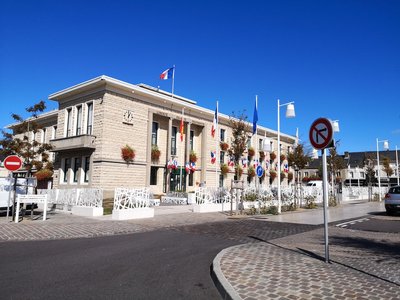
Hôtel de Ville de Duclair reconstruit en 1960 - Amis saint Colomban TouristDuclair City Hall
Although a human presence is confirmed by the existence of a Gallic camp, it was not until the Roman invasion that Duroclarum (a beautiful town) experienced an important civilization.
The commune is the result of the merger of the two ancient parishes of Duclair and Vaurouy ("Val Rouil" in 1469). The baron of Duclair is mentioned among the warriors of Hastings (1066). Occupied by the English in 1360. Important beer factory in the 15th and 16th centuries. Leprosarium, until the Revolution, on Mount Davilette.
A railway line linking Barentin and Duclair is inaugurated in 1881.
In 1928, the town hall and the village hall were inaugurated in the presence of the Minister of the Interior Albert Sarraut.
The town hall was destroyed during the bombing on 19 April 1944.
The present town hall was inaugurated on 15 May 1960.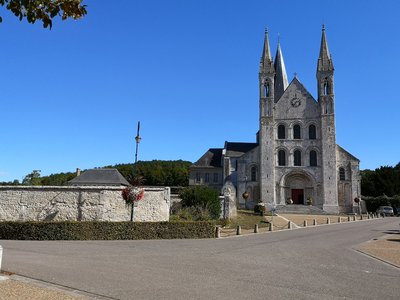
Église paroissiale Saint-Georges de Boscherville - Amis saint Colomban TouristSaint-Georges Abbey in Saint-Martin de Boscherville
In 1055, Raoul-le-Chambellan set up a community of canons in the small funeral chapel.
At first, the canons taught and preached with the support of the aristocracy, but then, having become rich and powerful, they attracted the hostility of their benefactors. Their role did not resist the rise of monasticism with its values of poverty and community life. Like the collegiate church of Boscherville, about thirty Norman collegiate sisters disappear. In 1113 or 1114, Guillaume de Tancarville, chamberlain to King Henri I Beauclerc, drove them out to found the Abbey of Saint-Georges de Boscherville. In the 13th and 14th century the abbey suffered disorders leading to the decline of this rich abbey. The regime of the commend and the religious wars will ruin the abbey. At the Revolution, the goods are sold and after the Concordat the parishioners transform the abbey church into a parish church.
L’entrée du Manoir de l’Aumônerie à Saint-Martin de Boscherville. - Amis saint Colomban HistoricalLe Manoir de l’Aumônerie ou Ferme des Templiers, La Génétey
The Manoir de l'Aumônerie is a rare example of 13th century civil architecture. The Manoir de l'Aumônerie was built by the Templars in 1214. The property is composed of numerous outbuildings and a medieval garden. On the estate is the Saint-Gorgon chapel, built in the 16th century. It was a famous place of pilgrimage until the 20th century. The Manor House has been listed in the supplementary inventory of Historic Monuments since 1974.
More information : site of the manor which is also a gîte.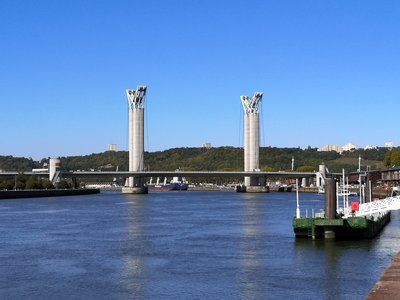
Le pont Flaubert avec ses deux pylônes papillons permettant de hisser le tablier du pont - Amis saint Colomban TouristThe Gustave-Flaubert bridge in Rouen
The Gustave-Flaubert bridge is a lift bridge which allows the Normandy motorway (A13) to cross the Seine west of Roeun, downstream of the first bridge (William the Conqueror bridge) which marks the limit of the part of the river accessible to sea-going vessels. Several solutions have been studied to facilitate the access of cruise ships and tall ships to the quays of Rouen.
A lift bridge. This solution requires the construction of high pylons on both sides to clear the maritime gauge. This solution makes it possible to clear the various constraints as closely as possible. Lifting the central span requires cutting off road traffic.
It was commissioned on 25 September 2008, after four years of work.
More information Wikipedia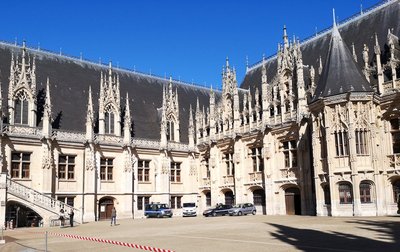
Le Palais de Justice de Rouen (XVIe siècle) - Amis saint Colomban HistoricalThe Palace of Justice in Rouen
The Rouen courthouse, one of the most emblematic monuments of the Norman capital.
Built for the most part between 1499 and 1507 to house the Parlour for the Bourgeois and the former Exchequer of Normandy, it became the Parliament of Normandy during the reign of François I in 1515, before being used as a courthouse from the French Revolution onwards. The building was enlarged in the 19th century towards Joan of Arc and Socrates streets.
By the scale and richness of its design, it bears witness first of all to the renewed prosperity of the city of Rouen at the end of the 15th century, renewing a previously neglected municipal heritage.
As an example of the Louis XII style civil architecture of the first decades of the 16th century, the monument was listed as a historic monument in 1840. Its architecture is similar to that of the Bourgtheroulde Hotel and the contemporary Finance Office.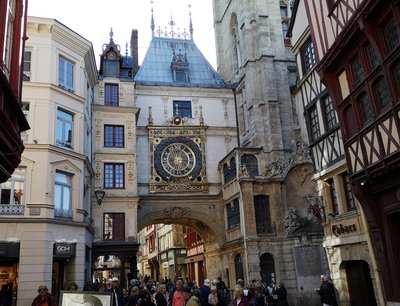
Le Gros-Horloge près de la Cathédrale de Rouen - Amis saint Colomban TouristLe Gros-Horloge in Rouen
Since its construction at the end of the 14th century, the Gothic belfry has housed the town bells and the town clock. The Big Clock is a Renaissance pavilion that spans the street with a low arch. On the double Renaissance dial, the single hand points the time. Under the number VI, the divinity symbolising the day of the week appears at noon on a chariot of triumph.
Above the dial, a globe indicates the phases of the moon. Everywhere sheep remind us of the importance of working with wool. The paschal lamb, represented in the centre of the arcade, symbolises the arms of the city. Finally, a Louis XV fountain completes the ensemble and celebrates the loves of the river god, Alphée, and the nymph Aréthuse.
A tour reveals the other side of the decor of this exceptional monument. In the pavilion, one reaches the dial room and in the belfry, one discovers the mechanism of the 14th century, the first municipal bells but also a unique panorama of the city.
More information Wikipedia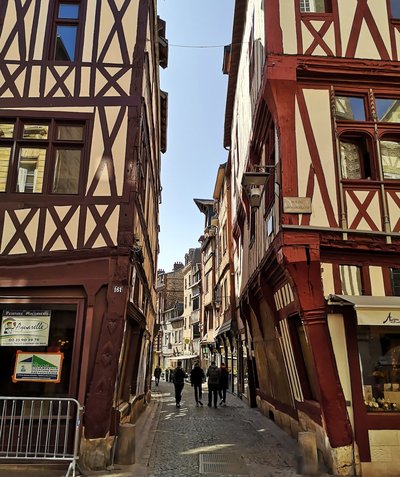
Maison à colombages avec débordement sur la rue du Gros-Horloge. - Amis saint Colomban HistoricalRemarkable houses in Rouen
It is hard not to notice the many half-timbered houses in the historic city centre. A symbol of Rouen's architecture, a half-timbered house is made up of a wooden frame and the hourdage. Corbelling, allowing the creation of floors overhanging the ground floor, developed as early as the 14th century. As the technique was perfected, it was still possible to see two, three, and even four-storey houses until they were banned in 1520 due to beliefs about the health fears of the plague and the risk of fire spreading.
The renaissance style of the Tourist Office will not leave you indifferent.
Historial Jeanne-d ‘Arc à Rouen - Rouen Patrimoine HistoricalHistorial Jeanne-d ‘Arc à Rouen
Discover a new kind of visit. Through a spectacular and innovative staging, take part in a real judicial investigation to discover the fate of Joan of Arc.
It is at the Joan of Arc Historical Museum that the trial of Joan of Arc is played out to re-establish her innocence. Be an actor and judge in the most famous judicial inquiry in the history of Rouen. Witnesses, reenactments and audiovisual effects will take you on a unique experience in the heart of the 15th century! From his military actions for the reconquest of the throne of France to his torture at the stake, live an epic and captivating story through the medieval rooms of a monument previously closed to the public.
Then go and meet the people who made her story and question them in a virtual tête à tête to discover the thousand faces of our heroine. After your visit, her myths and legends will no longer hold any secrets for you, so : See you in 1456!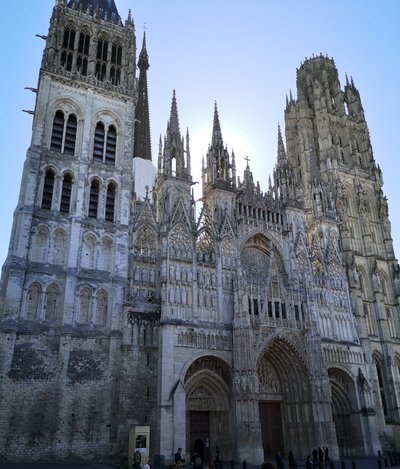
Façade de la cathédrale Notre-Dame de Rouen - Amis saint Colomban HistoricalNotre-Dame Cathedral in Rouen
The first church dates back to the 4th century following archaeological excavations at the end of the 20th century.
The importance of the building can be discovered from Côte Sainte-Catherine, on via Colombani 610 as you leave the city. These exceptional dimensions symbolize the rank of the archbishopric of Normandy in the Middle Ages in the 13th century, second duchy after that of France. The Duchy of Normandy, of which Rouen is the capital, became part of the kingdom of France in 1204. The sanctuary The choir still houses the recumbents of three dukes of Normandy (Rollon, Viking chieftain at the origin of the duchy, William 1st son of Rollon, Richard the Lionheart).
In the 11th century a Romanesque church was built, a century later the Gothic art can be seen in the whole building and makes its reputation. In the following centuries, the choir and the facade will enrich the gothic ensemble.
In the 19th century the Gothic spire was destroyed by lightning and replaced by a cast iron spire, at that time the cathedral was the highest in France.
During the Second World War the cathedral was heavily bombed and restoration work restored the building to its full splendour.
More informations : Wikipedia
Description
Leave the church square in Duclair by crossing the rue de Verdun and take the rue du 8 mai 1945, on the right place du Général de Gaulle, go around the square on the right, pass the town hall and then on the right rue du Paradis " Route des Panoramas ", cemented road, rue Bonnissent or Paradis, on the right Chemin du Panorama,
- On the left Chemin du Panorama, on the right Chemin du Clos de l'Ange, after the tennis court straight ahead on a dirt road, stay on your right, on the left route de l'Ânerie, on the right D43 route de Duclair, at the crossroads on the right Chemin de Gargantua, path in the wood, after passing under the high voltage line path on the right, go down towards the Seine Chemin de la Chapelle Sainte-Anne
- At the junction with D 982 route de Bord de Seine on the left, first road on the left towards Hénouville, stay on D86 on your right, first dirt road going up on the right, right at the crossroads and left at the next crossroads, straight on at the next crossroads.
- Turn left then right in the woods, red and white markings, go along the cemetery first path on the right in the woods, turn left, right down path, left chemin de la Cabotterie, turn right, dirt road with red and white markings, cross the Hérouville road D67, stay on the path which is parallel to the D67,
- Cross the D67, chemin de la Diligence, cross route de Duclair, road in front of you, turn right at the crossroads following route du Mesnil, right on D 67 rue des Iris, pass in front of Boscherville Abbey, straight ahead on route de Quevillon at the roundabout, left at the roundabout with red and white markings.
- In the woods, turn right on the first road, left on the second road, chemin Saint-Gorgon, at the roundabout, second road on the right, route Forestière du Génétey, at the crossroads, turn left on the D367, route de Quevillon.
- At the roundabout cross the D982 Duclair road, turn right Ancienne Route de Duclair, first street on the left, impasse du Clos aux Moines continue in the woods on a dirt road, turn right, stay on your right in the woods to bypass the subdivision.
- At the roundabout second road on the right D94 avenue du Président Allende, cross the street of Montigny, on the left Côte Guy de Maupassant D94e, in the small wood road on the right rue du Vallon, at the second crossroads on the left, rue Samuel Lecoeur D51
- At the roundabout turn right, rue Gaston Boulet, go under the motorway, rue de Bapeaume, turn right on boulevard Jean Jaurès, continue along the bus station avenue du Mont Riboulet, first street on the right, rue Amédée Dormoy, cross the quai Ferdinand de Lesseps, turn left on the Normandie-Niemen promenade.
- Pass under the William the Conqueror bridge, turn left, cross the double lane quai Gaston Boulet, take in front of you boulevard des Belges, third street on the right rue Racine, first on the left rue de Fontenelle, first on the right rue de la Pie, cross the place du Vieux Marché while staying on your right, rue du Gros-Horloge, cross the Cathedral square, go around it on the left, rue Saint-Romain, cross rue de la République, on the left in front of Saint-Maclou church, rue Damiette, rue des boucheries Saint-Ouen you arrive in front of the abbey church Saint-Ouen.
- Departure : Saint-Denis Church, Place de l’église 76 480 Duclair
- Arrival : Abbatiale Saint-Ouen, Place du Général de Gaulle. Rouen
- Towns crossed : Normandie
Altimetric profile
Report a problem or an error
If you have found an error on this page or if you have noticed any problems during your hike, please report them to us here:
Close by9
- Accommodation









